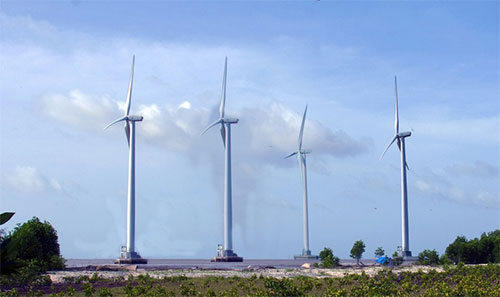Price rise agreement propels wind power growth

The Ministry of Industry and Trade (MoIT), in a document sent to the prime minister late July which has been seen by VIR, proposed that the power tariff at the Bac Lieu project should be set at 11.5 US cents for 1 kilowatt per hour during the first ten years and 9.8 US cents during the four following years. From the fifteenth year of the project, the power tariff should be at 6.8 US cents.
The proposed tariff is much higher than the 7.8 US cents fixed by the government under Decision 37/2011/QD-TTg.
According the MoIT, the higher tariff would make the Bac Lieu project effective given its expensive initial investment costs. However, the tariff that the MoIT proposed is still lower than Cong Ly’s original demand. The power investor previously proposed a tariff of 12 US cents for the first ten years and 10 US cent for four following years.
Cong Ly’s general director To Hoai Dan told VIR that although the MoIT’s proposed tariff was lower than he had hoped he thought it was an “acceptable” level. “We understand that we also have to share the burden with the government,” he said.
The wind power project, situated in southern province of Bac Lieu, is the second wind power connected to the national grid and follows in the footsteps of the Binh Thuan 1 wind power project in the central province of Binh Thuan.
The Bac Lieu project has total investment capital of around $45.8 million and a design capacity of 99.2 megawatts. Cong Ly has installed 10 turbines in the first phase and is planning to install an additional 52 turbines during the second phase.
“As this project is located on the coastline we had to spend lots of money on constructing the foundations for the turbines. We also used the most advanced turbines, which pushed up our investment costs,” said Dan.
He revealed the second phase of the project would start in May, 2014 and be completed in April, 2015.
“This is the first wind power project to be implemented on the coastline and is the first project of its kind in the Mekong Delta. Its success will pave the way for the development of more wind-power projects in the region,” Dan said.
What the stars mean:
★ Poor ★ ★ Promising ★★★ Good ★★★★ Very good ★★★★★ Exceptional
Latest News
More News
- PM urges Ho Chi Minh City to innovate and remain Vietnam’s economic locomotive (November 26, 2025 | 15:29)
- Experts chart Vietnam's digital finance path: high hopes, high stakes (November 14, 2025 | 10:56)
- Vietnam’s seafood imports surge 30 per cent in first 10 months (November 10, 2025 | 19:35)
- Vietnam’s durian exports hit $1 billion milestone (October 30, 2025 | 17:41)
- Beyond borders: Sunhouse and new era of Vietnamese brands on Amazon (October 28, 2025 | 10:46)
- Record-breaking trade fair set to open in Hanoi (October 15, 2025 | 15:59)
- Timber sector seeks solutions to VAT refunds (October 14, 2025 | 18:58)
- Tether explores investment prospects in Vietnam’s digital asset sector (October 10, 2025 | 18:09)
- Vietnamese investors pour nearly $847 million into overseas markets in nine months (October 08, 2025 | 18:42)
- Vietnam amends Law on Civil Aviation to create drive airport investment (October 03, 2025 | 18:29)

















 Mobile Version
Mobile Version